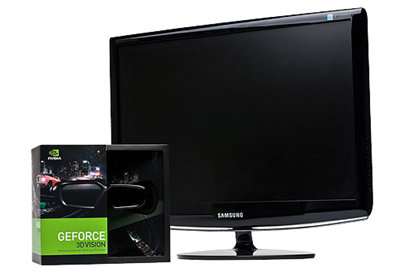Overview
NVIDIA hopes to reignite the world of 3D entertainment with GeForce 3D Vision. This HEXUS.help guide explains what it is, how it works, and what you need to know about the prospect of 3D gaming.
What is NVIDIA GeForce 3D Vision?
NVIDIA GeForce 3D Vision, launched in early 2009, is for all intents and purposes a set of 3D glasses. We’re not talking about the cardboard anaglyph (red/green) type, mind you, we’re talking about high-tech glasses equipped with stereoscopic technology – an imaging technique capable of creating the illusion of depth by displaying multiple 2D images.

As with many previous 3D glasses, you wouldn’t want to be seen wearing a pair of NVIDIA’s GeForce 3D Vision, but these aren’t designed to be worn outdoor – nope, they’re for use in front of a PC monitor, where they’ll endeavour to transform 2D imagery into an immersive 3D environment.
Using the high-tech wireless glasses, NVIDIA’s own drivers and a simple wireless receiver, the GeForce 3D Vision kit promises to automatically transform hundreds of PC games into full stereoscopic 3D.
However, judging by the lack of compelling 3D technology thus far – despite the best efforts of many in the technology industry – NVIDIA’s claims are bold to say the least, so how do these unsuspecting glasses make 3D gaming a reality?
How does it work?
NVIDIA’s GeForce 3D Vision adopts stereoscopic imaging technology. As its name implies, the technology uses two images (stereo) presented independantly to both the left and right eyes.
Whilst impossible to use stereoscopic technology on a single static 2D image, the same doesn’t apply to 3D games. Being rendered in real time, 3D games feature environments drawn and detailed with available depth information.
Using custom software to alter the way in which a game is rendered on-the-fly, NVIDIA is able to take that depth information and create two different images to be displayed independantly to each eye. It’s a gross simplification of a complex process, but the end result to the user is a set of images that independantly offer different views and come together to create the illusion of one three-dimensional scene.
As if that isn’t complicated enough, there’s plenty more invisible-to-the-eye technology working behind the scenes, too. In order to feed these differing images to the human eye seemlessly, NVIDIA’s 3D Vision glasses feature Liquid Crystal lenses that – in tandem with a game’s frame rate - flicker on and off numerous times each second. In order to ensure the flickering remains unnoticable to the human eye, the 3D Vision glasses require the use of a display capable of a 120Hz refresh rate.
Herein lies one of 3DVision’s biggest obstacles.
Are there any provisos?
As mentioned, NVIDIA’s GeForce 3D Vision requires a display capable of a 120Hz refresh rate. Today, those displays are few and far between and relatively expensive when compared to the widely available 60Hz alternatives.
At present, only the following display options are officially certified for use with GeForce 3D Vision by NVIDIA:
- Samsung SyncMaster 2233RZ LCD
- ViewSonic FuHzion VX2265wm LCD
- 100 Hz and higher analog CRTs
- Mitsubishi 1080p DLP Home Theater TV
- DepthQ HD 3D Projector by LightSpeed Design
It’s a limited choice – and it creates the hurdle of up-front costs that many users may find difficult to justify. In an effort to make the technology easier to adopt, NVIDIA offers customers a GeForce 3D Vision Bundle – comprising of the stereoscopic glasses kit and a 22in Samsung SyncMaster 2233RZ LCD. However, at a cost of approximately $600, the bundle is notably more costly than the $200 glasses alone.

The display, unfortunately, isn’t the only proviso. Despite offering a simple instalation and easy-to-use software, NVIDIA’s GeForce 3D Vision is only compatible with computers equipped with GeForce 8, 9 or GTX 200-series graphics cards.
Furthermore, despite promising to transform hundreds of games into 3D, would-be buyers should note that it isn’t applicable to every title available. Although NVIDIA pledges to work closely with game developers to provide a realistic 3D experience in modern games, users will be aware that an overwhelming number of games aren’t developed for 3D purposes.
Therefore, the quality of NVIDIA’s GeForce 3D Vision effect can vary greatly. With this in mind, users are strongly advised to check NVIDIA’s game support list to ensure their favourite titles provide a good 3D experience, and where possible refer to third-party reviews.
Summary
In spite of bringing 3D entertainment back into the limelight, NVIDIA’s GeForce 3D Vision remains a little rough around the edges. Armed with plenty of potential, it can provide dazzling 3D imagery in the right scenario, and little more than a headache when used with less-compatible games.
Nonetheless, 3D is a technology we’ll be hearing a lot more of throughout 2009 as major movie studios, TV broadcasters and the PC industry appear to be adament that three-dimensional viewing is the next major step forward.
We’re not quite immersed just yet, but NVIDIA’s GeForce 3D Vision is another promising step forward.













